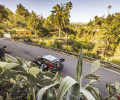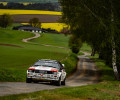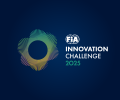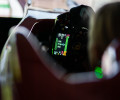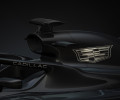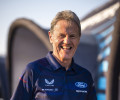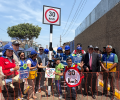F1 - Korean GP: Press conference 2

PRESS RELEASE
TEAM REPRESENTATIVES – David GREENWOOD (Marussia), Mark GILLAN (Williams), Pierre WACHÉ (Sauber), James ALLISON (Lotus), Paddy LOWE (McLaren), Adrian NEWEY (Red Bull Racing)
David, you’ve made progression in 2012, presumably you’re hoping to carry that through to 2013. How is work progressing on that car?
David GREENWOOD: I think it’s been mentioned many times, the aero rules are quite consistent between 2012 and 2013, so a bit like a few other teams we opted to stay developing this car a little bit longer but now we’ve firmly switched over to the ’13 car and that’s going reasonably well. A little bit of layout change required because of the KERS, so it’s taken a few wind tunnel sessions to start getting into that with different wheelbases etc., so really that’s what the aero guys are focussing on. To mention the KERS, obviously quite bit of installation work going on to there to get that into the car from the design guys. But that’s gone reasonably well, the first chassis is in manufacture and the guys are starting to do sample crash tests, so we’re in a lot better position than maybe we were last year. So hopefully with doing a bit more of our homework earlier one, we’re looking to progress.
You’re in the intriguing position of having technical partnerships with two other teams: McLaren and Williams. How does that work and what are the benefits to that?
DG: Starting with the McLaren one, which is the first one we did, with McLaren Applied Technologies, it’s going very well. We’re pleased with the wind tunnel, we’re pleased with the correlation we get to the circuit, which is one of the things that’s given us the ability to progress at the back end of this season. Most updates that we’ve had have done what they should, so that’s been very pleasing. The simulator programme is going well, particularly helping Charles with learning circuits. This back end of the year has been perhaps circuits that he’s not used to, so that’s been a valuable tool for him. Moving on to Williams, we’re exceptionally pleased with the support we’ve had from them on the installation of the KERS. It’s been really, really good support from them and it’s enabled us to get it into the car relatively easily and all of that work has gone well so far.
Mark, we’ve seen the Williams good in the first part of the season, then there was a less productive middle part, and now it seems to be coming back again. How do you see the season so far?
Mark GILLAN: In terms of pace, our performance has been improving through the season – we just haven’t capitalised on the general pace of the car. We obviously had a high point at the beginning, at Barcelona, and really haven’t delivered the points that we should have over the last number of races. Hopefully the last race was a turning point: we didn’t qualify as strongly as we were hoping, the race pace was very good but we need – as you always do – to string it all together through the weekend. And that’s something that we have to aim to do.
And plans for the rest of this season and maximising the good points of this car for next year?
MG: Last season we basically spent the last six events developing the car for this year and understanding the weaker points on last year’s car. This year we’re really pushing to the end of the season with development, and balancing the development all the way to the end of the season with 2013 – and obviously very importantly 2014 as well.
Pierre, I guess the burning question is ‘can you catch Mercedes?’
Pierre WACHÉ: I don’t know. What I know is our car performed well in Suzuka, we had quite a good car. I don’t know if for these kind of races we’ll be at the same level but I think it will be more challenging for us in qualifying, maybe more in the field – but we can expect good performance for the race.
Can you maintain this car for next year? It’s interesting that things have slightly changed on the technical side of the Sauber team.
PW: I think we can maintain and improve what the car is delivering at the moment for the next year. Clearly we follow the same concept in terms of developing the car, make a good basic of the car and try to improve the weakness of the last year’s car, like we did this year. And try to do that in the most efficient way. It’s what we try to do: to use as less resource as possible but for the maximum performance and be able then to develop the car during the season.
James, everyone’s talking about the modifications here, and whether they’re working or not. What the general viewpoint?
James ALLISON: Reasonably happy with the way they’re working. I think we’re at the beginning of a relatively long road with them – they’re not straightforward to make work perfectly first go out. But the numbers we’re getting from them are good, so yeah, quite pleased.
Romain Grosjean yesterday said you know the weaknesses of this car. What are you able to do about them?
JA: Same as anyone else – you just chip away at them. It’s an annoying sport this: you can think you’re making progress and then everyone else gives you a wake-up call. But we’ve got a good team back at the factory and a good team here at the track. We just keeping working away at the things that aren’t so good and try to make the things that are good even better. It’s always the same job.
Paddy, five races to go and according to the FIA sheet you’ve used all eight engines. Is that a concern?
Paddy LOWE: No, not at all. We’re working exactly to the plan we set out at the beginning of the year. I think, like all the teams, we deploy our engines in what we consider the optimal pattern across the different races. Some circuits are better for power than others, so we happen to have used engine number eight where we thought it was best. Other teams have different solutions. But there’s no concern at all, it’s all to plan.
You seem to have had a few reliability issues of late. Would that be fair to say?
PL: It hasn’t been what we’d like. I think if you look on a historical level it hasn't been that bad but they all came in a bit of a bundle through Italy and Singapore. Very unfortunate for us but actually overall, looking at the season, it hasn’t been so terrible.
Adrian, Japan looked so good, is that representative of the circuits for the rest of the season would you say?
Adrian NEWEY: It’s very difficult to tell, I think. We’ve seen swings from race to race, team to team all through the year. That’s been one of the hallmarks of the year. You’ve only got to look at Mercedes performance in China, which looked so dominant, yet they’ve been less dominant on other races. So I wouldn’t like to predict anything on the basis of one race.
Here there are so many different characteristics of this circuit. You look good in the third sector. Is that a sector you concentrate on? Do you concentrate on one sector of a circuit?
AN: No. It’s a tale of two tracks here in as much as the first is very long straights. Engine power is important. And then you’ve got the rest of the lap, which is quite twiddly, so you can get quite big swings between the various sectors.
If I can come back to David Greenwood: the same question for you about eight engines, with Charles Pic. Is that a concern for you?
DG: Yes, I would say so. At the minute that is a concern on where we are with the engines.
So it’s not tactical?
DG: Perhaps not in our case.
QUESTIONS FROM THE FLOOR
Q: (Miguel Sanz- Marca) Mr Newey, do you think it's possible that one of the final five circuits won't suit your car? Is there any chance?
AN: It's wholly possible. Just don't know which ones yet! As I said, I don't know which one yet.
Q: (Kate Walker - Girl Racer) James, you're one of the last teams if not the last team to play around with the coanda effect. I know you've had it in development for a while. What was it that took so long to get it to the track?
JA: Well, at the point when we were committing to what we were going to start the season with, we had two paths, a coanda path and what we chose which was a very simple exhaust which was there to optimise power. At the time, the coanda solution was worth a little bit more theoretically than the power maximising solution but you had to be confident that it was going to deliver all the downforce that it promised, because you could be fairly certain that it was going to deliver all the horsepower loss that the more convoluted exhaust pipe requires. So if the downforce didn't materialise, you knew you were down on the deal, so where we were when we launched our car, that was a relatively finely balanced decision. We launched with the simple thing and then we got under way and have had a reasonably bright season and have been pretty competitive deep into the year. We kept working on the other solution because it was fairly clear that that was where the centre of gravity of opinion in the pit lane was and also because it was a reasonably productive avenue back in the wind tunnel. It got to a point where the gain of the coanda system was sufficiently far ahead of our previous race system that it was quite clearly something that we ought to look at both for this year and also to make sure we're doing the right thing for next year. That's pretty much the history of it; probably could have committed a bit earlier but then things were going quite well for us on the track as well.
Q: (Daniel Ortelli - Agence France Presse) James, are you going to again try your double DRS or are you slowly giving up on that project?
JA: Certainly not giving up on it because there is some goodness in there but that really is tricky - well, we've found it so anyway. So we will keep working on that but you probably won't see it as much on Fridays; we're going to bring it out to play again at the young drivers' test and hopefully make a bit of progress there.
Q: (Vanessa Ruiz - ESPN Radio) Some drivers mentioned that they could not practise on the simulators for the Korean Grand Prix because the teams didn't have the laser models. Did that happen to all your teams, and secondly, to use an expression that Mark has just used, how does that affect the capitalisation of your cars?
AN: Well, yes, Mark went in the simulator prior to leaving for Singapore, did both Singapore and Korea. Sebastian, to the best of my memory, didn't do Korea. I think, really, the level that Formula One drivers are at - the more experienced ones, certainly - then they don't really need to go in the simulator, if you like, to warm themselves up and remember whether turn one's a lefthander or a righthander. As you started to hint at in the second part of your question, it's more for the engineers to understand what's required at that circuit, but at the same time, everybody has simulation techniques as well. The only difference, really, between simulation and simulator is that one has the driver in the loop, the other is effectively driven by the computer. We're not going in blind, we've had two years of experience at this track so I don't honestly see it as a particularly big factor.
DG: I think, from our perspective, it was a little bit more difficult for Charles to learn Korea versus Japan because of the quality of the track model. That has shown up a little bit this morning. He did say it was harder and definitely in Japan he got more on the pace quicker. It's not ideal but we're all in the same situation, so that's what we use and we get on with it.
MG: I agree. The level of fidelity of the simulator model obviously depends on the quality of the laser scan or whatever other information you can extract from it. What Adrian says is quite true: the more experienced the driver, the less they require the simulator in terms of preparing for the event but for instance, with Valtteri, who has not been round this track before, the simulator is a very important tool, so he maybe spent a little bit more time getting up to speed with the track than he may have done if we had had a very detailed model.
PW: For us, we don't have a simulator so it doesn't change anything for us, compared to other tracks. For sure, in this case the driving time during Friday is very important and also the set-up is defined by simulation before Friday and to leave as much time as possible for a good set-up for the driver, so then he can train on the track.
JA: Neither of our two drivers had been here, and I don't think Kimi had even been round the track but you could see how quickly both of them adapt to it. I think any racing driver worth his salt can very quickly come to terms with the track and I really don't think I can add much more to what Adrian said. The driver-in-the-loop simulator is much more for the engineers than it is for the driver.
PL: Yeah, the same. I think ultimately it just affects the quality of that particular track that you create and it would mean that this wouldn't be a circuit that you would use for very in-depth studies because we don't have that data, but it doesn't actually affect this event particularly for us.
Q: (Edd Straw - Autosport) James, will you continue to run the new exhausts tomorrow?
JA: I think so, yeah. We haven't decided yet but it looks like we will.
Q: (Daniel Ortelli - Agence France Presse) Is anyone of you brave enough or senior enough to tell us what's on the agenda of the October 23rd meeting in Paris?
PL: Well, we had a meeting in - was it May or June? - yeah, we had a meeting in Monaco in May and I believe there was going to be a second meeting in August or late July and this is that meeting postponed. It will be to continue the same agenda which is about cost-saving and regulations.
Ends
For Media Information Purposes - No Regulatory Value.

 Facebook
Facebook Twitter
Twitter